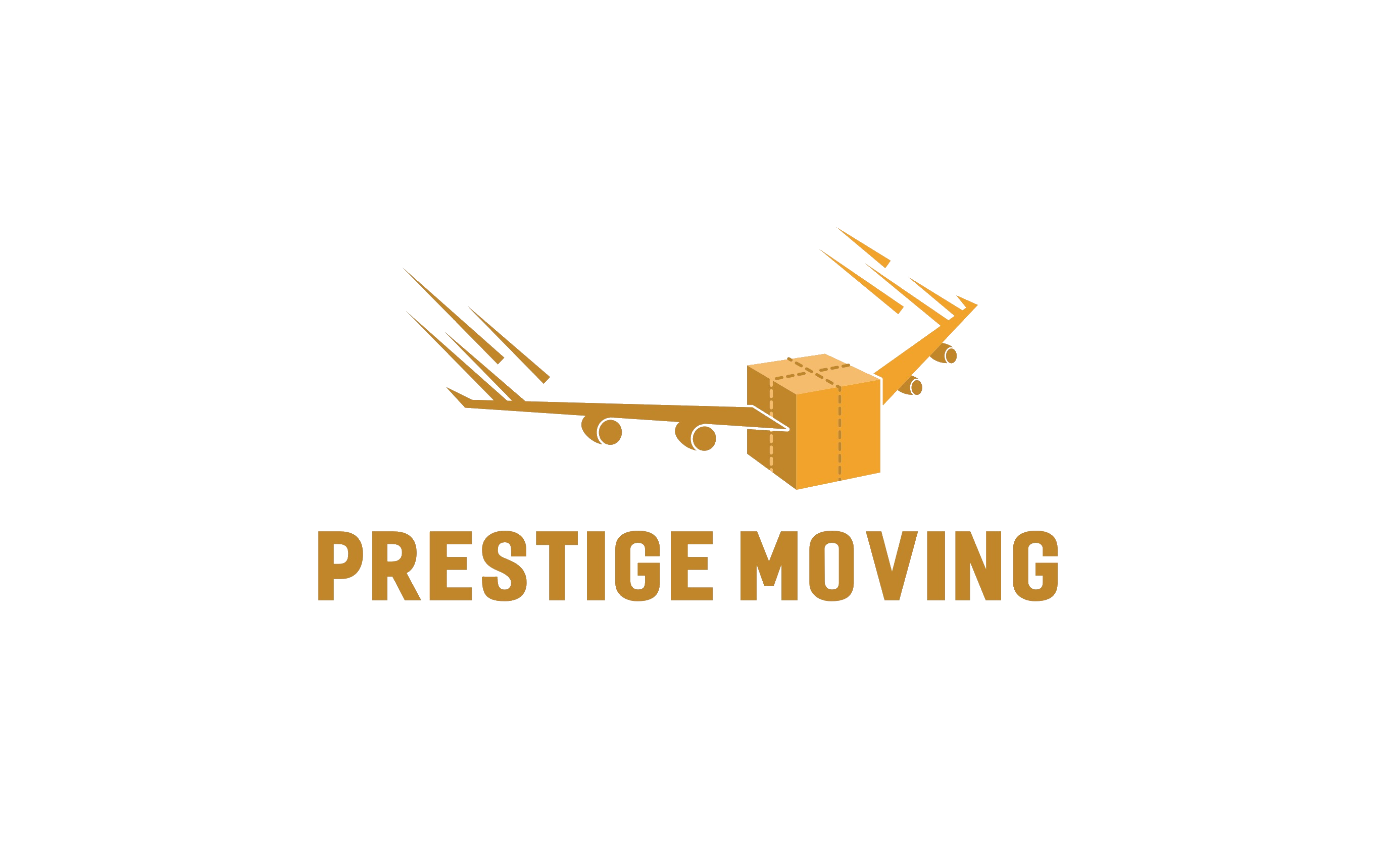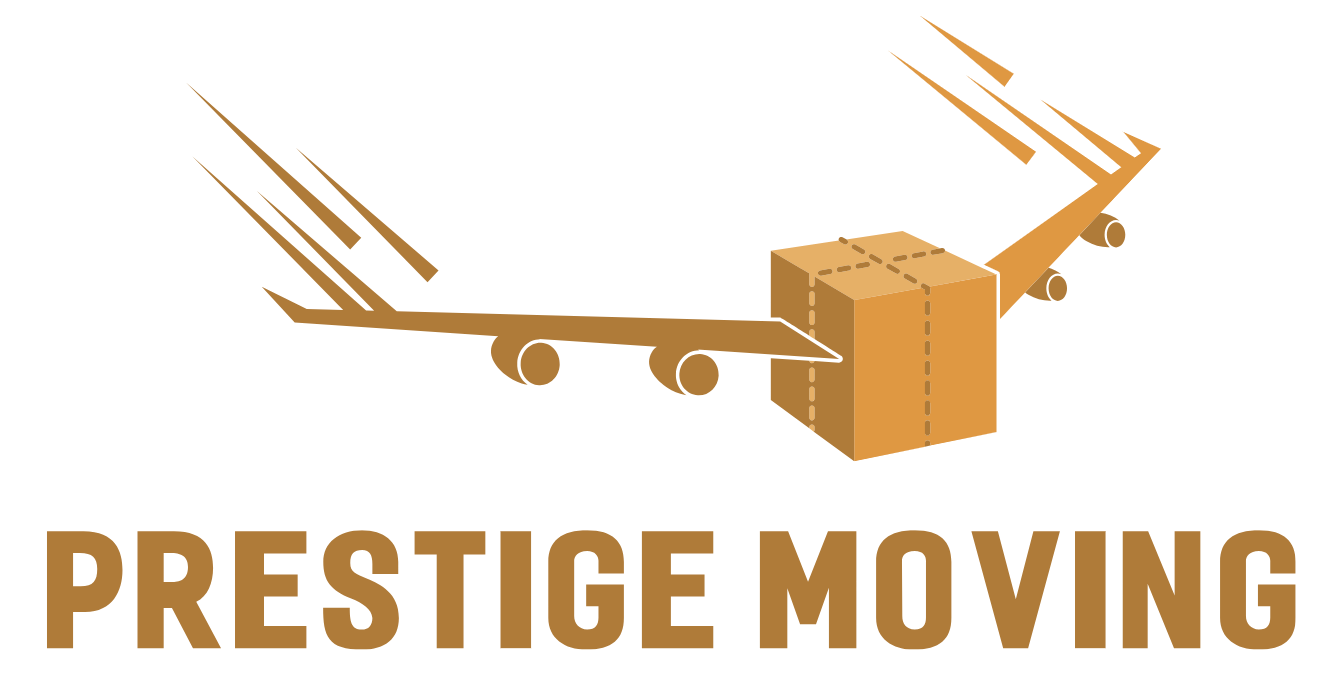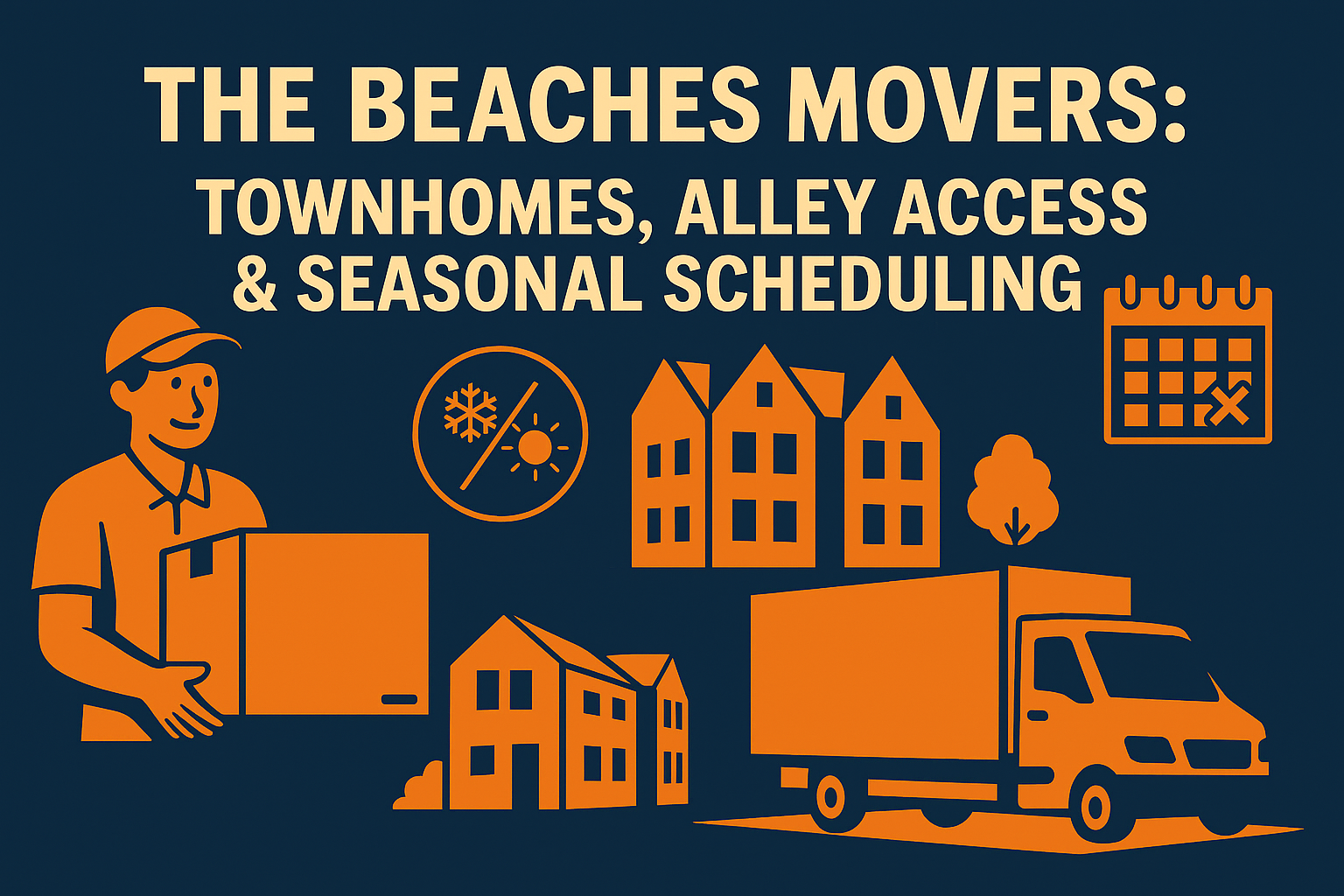Moving in The Beaches: A Precision Playbook for Townhomes, Alleys, and Peak Dates
The Beaches blends boardwalk calm with downtown energy—and that duality shows up on moving day. Narrow streets, laneway houses, townhome stairwells, and strict seasonal windows mean your plan must be sharper than a standard condo move. This guide breaks down how to move efficiently in The Beaches, with specific strategies for townhome floor plans, alley and laneway loading, street-permit logistics, and season-by-season scheduling to lock the dates (and rates) you want.
Along the way you’ll find actionable checklists, crew-time estimates, equipment choices, and neighbourhood-tuned tactics—plus relevant internal resources (related Toronto neighbourhood guides) and authoritative external links for permits and essential services.
The Townhome Factor: Stairs, Narrow Landings, and Split Loads
Assess the Vertical Path (Before You Book)
Most Beaches townhomes run 2–3 storeys with tight turn radii (29–32 inches) at landings. This affects:
- Crew size (add a third mover for continuous shuttling)
- Time estimates (budget +20–35% vs. elevator moves)
- Equipment selection (shoulder straps, forearm forklifts, neoprene corner guards, 4-wheel dollies)
Pre-measure checklist:
- Clearance for sofas/sectionals (L-shape pivots on stair turns)
- Mattress sizes (queen vs. king final turn to primary)
- Fridge depth and stair bullnose overhangs
- Basement access (dehumidifier, sump pit area—watch for tight doorjambs)
Pro tip: Stage heavy pieces on the main floor beforehand. The goal is to reduce vertical repetition and keep the load moving to the truck.
Disassemble with Intent (Not Overkill)
- Remove legs from couches and tables; hinge-pin doors can be lifted when the last ½ inch is the difference.
- Platform beds: bag hardware and label slats per room to speed reassembly.
- Banister off? Only if needed and only by a qualified tech. Pad beyond the work area to protect hardwood.
Pack Like a Pro for Stair Efficiency
- Uniform small boxes (1.5 cu ft) for books and pantry—fast hand-to-hand passing on stairs.
- TVs in original boxes or foam corners, then strap to a panel dolly.
- Wardrobe boxes for zero-fold closet moves; stage at landing to prevent stairway clogs.
For professional packing options and timelines, see the Toronto condo/loft analogues in nearby neighbourhoods like Leslieville Movers: Guide & Tips—the packing and elevator-free strategies transfer well to Beaches townhomes.
Alley & Laneway Access: Load Positioning, Neighbours, and Truck Specs
Scout the Lane 48–72 Hours Out
- Width test: If a 16–20 ft box truck is too large, plan a shuttle strategy—cargo van or 10–12 ft truck from lane to a larger curbside truck.
- Overhead hazards: Low lines/branches, garage overhangs, and tight ingress/egress angles.
- Turn-around: If no loop, plan a back-out escort with spotter and cones.
Protect Shared Surfaces
- Rubber mats at lane entrances
- Neoprene edge guards on brick/garage surrounds
- Plywood runners if rolling dollies over knuckled pavers
Communication Board for Neighbours
Print a simple “Moving Day Notice” for laneway neighbours:
- Date and time window (load-in/load-out)
- Contact number for the crew lead
- Polite note on temporary lane use and a thank-you for cooperation
Neighbourly notice reduces complaints and makes crews faster. For more laneway and loading-zone strategy, compare approaches from tighter downtown zones like the Downtown Toronto Movers Guide.
Parking & Permit Logistics in The Beaches
Curbside Strategy on Queen St E and Side Streets
- Primary truck placed at the closest legal curb to the front door or alley mouth.
- Cone a safety lane beside the ramp; add “Moving in Progress” signage so cyclists/pedestrians clock the hazard.
- No-standing windows near intersections are strictly enforced—build in alternate side-street options.
When You Need a Permit
If you’re reserving curb space, a temporary street occupation/parking permit may be required, especially near high-traffic stretches or where rush-hour restrictions apply.
- External Resource: City of Toronto — Street Occupation Permits (guidance on temporary lane/curb use and conditions).
Learn more: City of Toronto Street Occupation Permits
Lead time: Apply 7–10 business days ahead for peak months; off-peak can process faster but never assume same-day approvals.
Condo or Co-op Intersections
Even if you’re moving to/from a low-rise townhome, many Beaches residents transition from downtown condos. Elevator booking rules and dock reservations often apply on the origin side:
- Load-out window control: 2–3 hours standard.
- Deposit requirements: Damage deposits and moving blankets are mandatory.
- Dock height: Confirm if a dock-height truck is required or if box-truck with ramp is acceptable.
Neighbourhoods with similar rules and docks include St. Lawrence Market Movers: Guide and the Distillery District Moving Company overview.

Seasonal Scheduling: Beat the Peaks, Book the Best Windows
Spring Surge (Late March–May)
- Townhome turnover spikes as listings close; expect tighter calendars on weekends.
- Strategy: Book AM arrival to maximize light and lane visibility; winds off the lake can make ramps slick—bring anti-slip treads.
Summer Peak (June–August)
- Highest demand. Saturdays can sell out 3–5 weeks ahead.
- Heat mitigation: Hydration plan, stair rest cadence, and stops every 45–60 minutes on 3-storey hauls.
- Rate control: If flexible, choose Tue–Thu, midday windows.
Fall Value Window (September–October)
- Stable weather, better availability, cooler temps (ideal for multi-storey stairs).
- Family moves targeting school-year stability prefer early September; book 2–3 weeks out.
Winter Smart Moves (November–February)
- Lower demand (except late December).
- Safety gear: Salt, shovel, entry mats, and ramps with cleats.
- Lake-effect wind can increase chill; pack electronics carefully and acclimatize TVs before powering on.
For neighbourhood-specific timing comparisons, skim the King West & Liberty Village Movers guide—urban density changes the optimal windows, while The Beaches rewards weekday, mid-morning start times for lane access.
Load Plans That Win in The Beaches
Option A: Single-Truck Curbside + Short Carry
- Best when: Front-door access is clear and parking permits secured.
- Crew: 3 movers + driver/lead
- Pros: Fastest line from door to deck; minimal staging
- Cons: Exposure to traffic enforcement during rush periods
Option B: Laneway Shuttle + Curbside Primary
- Best when: Alley is tight or neighbours need constant lane access
- Crew: 2 movers on shuttle, 2–3 on main truck
- Pros: Keeps lane open; reduces neighbour friction
- Cons: Extra transfers—add 15–25% time
Option C: Two-Truck Stagger (Origin/Drop)
- Best when: Timing must match elevator bookings at origin and permit windows at destination
- Crew: 2 staggered teams with synced leads
- Pros: Calendar precision; less idle time
- Cons: Requires flawless comms; slightly higher base cost
Packing Matrix for Beaches Townhomes
Room-by-Room Priorities
- Basement/Storage: Early purge; humidity-safe binning for seasonal gear
- Kitchen: Double-wall dish barrels, label by cabinet location (e.g., “Kitchen – North Wall – Uppers”)
- Living/Media: Foam corners + stretch wrap; label cable bundles by device/room
- Bedrooms: Wardrobes for hanging clothes; roll, don’t fold for linens to save box space
Materials That Pay Off
- Reinforced book boxes (no flex on stairs)
- Reusable bins for small, loose items (child/pet rooms)
- Door jamb protectors and stair runners to keep your damage deposit safe
Cost Drivers Unique to The Beaches
- Stairs & Long Carries: Each additional floor can add 0.5–1.0 labour hour depending on volume.
- Shuttle Moves: Expect +15–25% to total time.
- Permit & Parking: Admin plus any municipal fees.
- Seasonal Premiums: Weekends in June–August carry the highest demand.
- Specialty Items: Upright pianos, gym equipment, antique armoires—pad/strap/crate time applies.
For a downtown comparator and rate-planning context, review the operational nuance in The Annex Movers: Heritage Homes, Parking Permits—heritage constraints echo Beaches’ older-stock layouts.
Risk & Insurance: Protect Floors, Walls, and Valuables
- Entry protection: Ram board or corrugate in high-traffic zones
- Banister wrapping: Furniture pads + tape over shrink (no adhesive on finish)
- COIs: If building management requires Certificates of Insurance, have them issued 48–72 hours before move day
- High-value inventory: Photograph, list serials, and flag to crew lead at start of job
Services to Consider for a Smoother Beaches Move
- Full or Partial Packing: Tight stairwells benefit from uniform box sizes and pro tape jobs
- Disassembly/Reassembly: Beds, sectionals, dining tables—label bags and use colour-coded tape for rooms
- Storage Buffer: If closing dates misalign, short-term storage avoids rushed unloads
- Debris Pick-up: Post-move carton sweep keeps lanes/curbs spotless (eases neighbour relations)
If you’re weighing DIY packing vs. pro packing in an urban setting, see the dense-zone lessons in Downtown Toronto Movers Guide and Leslieville Movers Guide—they map closely to Beaches realities.
Administrative Essentials Before You Roll
- Canada Post Mail Forwarding (set up 5–10 business days prior):
Start here: Canada Post — Mail Forwarding - Utility Transfers: Hydro, gas, water, internet (lead times vary; aim for 10–14 days out)
- Move-Day Weather Plan: Extra mats, salt, and towels for lake-effect sudden shifts
Seven-Day Countdown for The Beaches Townhome Move
T-7: Finalize permit approval; neighbour notices in alley
T-6: Confirm truck size; if shuttle required, secure the second vehicle
T-5: Pack non-essentials; stage basement/attic early
T-4: Protect banisters; pre-wrap framed art and mirrors
T-3: Confirm parking plan with the crew lead; share lane photos
T-2: Disassemble beds and dining table; bag hardware and label
T-1: Clear stairwells; set “first off” box for essentials (router, remotes, meds)
Move Day, 08:00–10:00 (ideal weekday window):
- Walkthrough with crew lead
- Assign room colour labels
- Confirm load order (storage/basement first, then living, then bedrooms)
Frequently Asked Questions (FAQs)
1) Do I need a special permit to park a moving truck in The Beaches?
If you’re reserving curb space or using a lane that affects traffic, yes—street occupation/temporary lane permits may apply. Start with the City of Toronto guidance and apply 7–10 business days ahead for summer weekends.
2) How many movers should I book for a 3-storey townhome?
Typically 3–4 movers depending on volume and stairs. If a shuttle is required from laneway to curb, a 2+2 split boosts speed.
3) Is a weekday move really better in The Beaches?
Yes. Tuesday–Thursday, mid-morning windows minimize commuter traffic and curbside competition, particularly near Queen St E.
4) What’s the best way to move a sofa up narrow Beaches stairs?
Pre-measure the turn radius, remove legs, wrap tightly, and pivot “high-low” with a third mover spotting. Consider stair sliders or shoulder straps for control.
5) How do I keep neighbours happy during a laneway move?
Share a courtesy notice 48 hours prior, keep cones and a clear egress, and schedule a shuttle if the lane is narrow or high-use.
Related Neighbourhood Guides (Toronto Focus)
- Leslieville Movers: Guide & Tips – Similar townhome and laneway patterns; packing strategies transfer one-to-one.
- Downtown Toronto Movers Guide – Permit, dock, and elevator frameworks for dense cores.
- St. Lawrence Market Movers: Guide – Dock heights, weekday scheduling, and concierge rules.
- Distillery District Moving Company – Loading zone strategy and concierge bookings in heritage zones.
Your Beaches Move—Handled with Precision
Moving a multi-storey townhome in The Beaches isn’t just “truck and boxes.” It’s lane scouting, stair choreography, permit timing, and neighbour management—all executed in a tight seasonal window. With the right crew size, a smart truck plan (curbside vs. shuttle), and weekday scheduling, you can protect your property, keep the lane civil, and finish on time.
Ready to plan the details and lock your preferred dates?
Contact our team to get started


